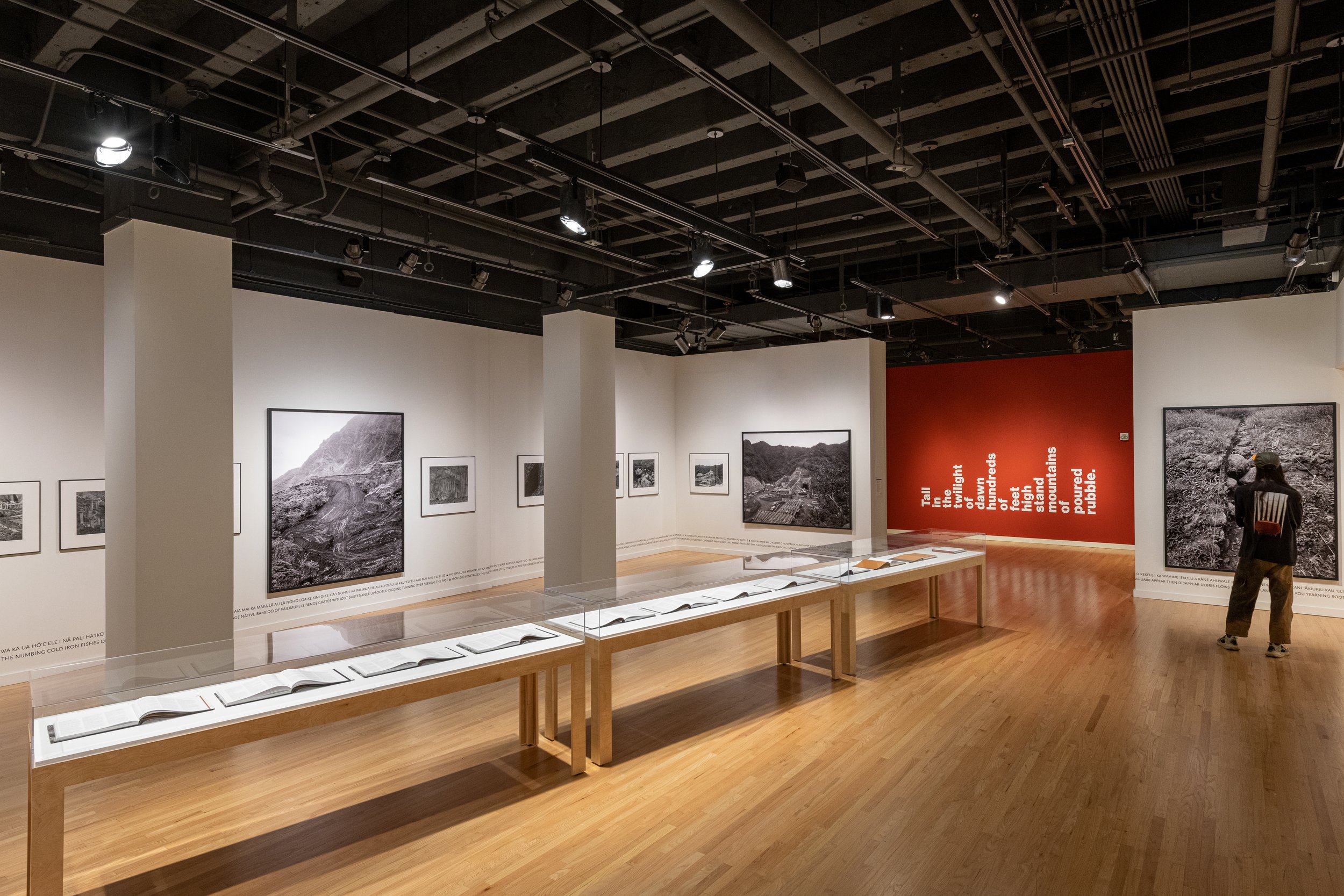hawai‘i triennial 2022
@ HAWAI‘I STATE ART MUSEUM
Piliāmo‘o
Mark Hamasaki
b. 1955, Fort Belvoir, Virginia (U.S. Army Base);
lives and works in Kāneʻohe, Koʻolaupoko Oʻahu
Kapulani Landgraf
b. 1966, Pūʻahuʻula, Kāneʻohe, Oʻahu; lives and works in Pūʻahuʻula
[TOP] Installation views: Piliāmo‘o (Mark Hamasaki and Kapulani Landgraf), Hawai‘i State Art Museum, HT22, Honolulu. Courtesy of the artists and Hawai‘i Contemporary. Photos: Christopher Rohrer. [ABOVE, FROM LEFT] Piliāmoʻo, HO‘OPĀLUA ‘IA KA MANA WAI O HĀLAWA 9.8.91 HĀLAWA, 1991, silver gelatin print, 50.8 x 40.64 cm and ‘A‘OHE ‘ŌIWI 4.29.90 LULUKU, 1990, digital print, 152.4 x 190.5 cm. Courtesy of the artists. © Piliāmoʻo.
Piliāmoʻo (1989–) is the collective name for photographers Mark Hamasaki and Kapulani Landgraf’s shared practice. Deeply rooted in the particularities of place, Hamasaki and Landgraf have collaboratively documented transformations across the ahupuaʻa of Koʻolaupoko on the island of Oʻahu for over thirty years—including the water struggle of Waiāhole, Interstate H-3 in Kāneʻohe, and the modernization of Kailua. Piliāmoʻo’s visceral project Ē Luku Wale Ē: Devastation Upon Devastation (1997–), which makes visible the terminal stages of the construction of the H-3 highway and its destruction of cultural, agricultural, historical, and environmental sites of significance, is the focus of their work for HT22.
H-3 opened to Oʻahu’s motoring public in December 1997 after decades of controversy and resistance. As part of the Dwight D. Eisenhower National System of Interstate and Defense Highways, the scenic roadway received over a billion dollars in federal funds to link what are now known as Joint Base Pearl Harbor-Hickam, on the island’s leeward side, and Kāneʻohe Marine Corps Base on the windward side. Championed by U.S. senator Daniel K. Inouye, the project was eventually exempted from environmental law as a rider on a 1986 appropriations bill (H.J. Res. 738), allowing it to cut through the rural valleys of North Hālawa and Haʻikū.
Piliāmoʻo documented the project’s progression every Sunday, when construction crews were off-duty, from March 1989 into the late 1990s. Peopleless, their photographs foreground absence, erasure, and the marks inflicted on lands and waters of the valleys. Over the course of several years, Piliāmoʻo steadily amassed a crucial kūʻē-archive comprising thousands of photographic documents—counter-evidence to official stories and statements issued by state representatives at the time. From their kūʻē-archive, Piliāmoʻo composed a visual essay (1997); wrote kanikau, dirges (1997, 2015); developed solo and group exhibitions (1997, 2016, 2017, 2019); and published an extensive book (2015), all as part of the ongoing and iterative Ē Luku Wale Ē: Devastation Upon Devastation.
Consciously employing and subverting the formal language of early twentieth-century American landscape photography and land-surveying traditions, Piliāmoʻo replaces sublime landscapes and mapped territories with their emotional responses to scenes of devastation. Ē Luku Wale Ē contrasts stereotyped assumptions of photographic depictions of Hawaiʻi’s rural valleys—paradisiacal, serene, and untouched—all the while mourning what has been lost forever in the name of progress. A verse from the kanikau, composed by Landgraf, expresses Piliāmoʻo’s grief:
Nui ka hewa ma Kukuiokāne
hoʻopunipuni nā iʻa me nā niho kīlou
Kanu nā pōhaku heiau o Kāne
kūpilikiʻi i Punaluʻu kukui paʻi aʻa lā
Ke kūpaka nei ʻo Kahoe
kahe koko ke koʻa mokumoku o Loʻe
Hanehane nā kumupaʻa i māʻehaʻeha
olo e makena e ʻuwā ana ē
Kau ʻeliʻeli kau mai kau ʻeliʻeli ē.
Extensive deceit at Kukuiokāne
fishes with iron claws controlled fraudulently
Heiau stones of Kāne lay buried
Punaluʻu’s kukui its rooted veins distressed
Kahoe tortured with grief
torrents bleed upon Loʻe’s broken coral
Excruciating pain of the ancients
weeps wails roils
Digging turning over revealed.
FROM TOP: Mark Hamasaki. Photo: Kapulani Landgraf. Kapulani Landgraf. Courtesy of the artist.
Piliāmo’o is the collective name of Mark Hamasaki and Kapulani Landgraf. Collaboratively, they have documented the construction of the H-3 freeway, the water struggle of Waiāhole, and the ahupuaʻa of Kailua. In 2015, ‘Ai Pōhaku Press published a 167-page photographic essay Ē Luku Wale Ē by Piliāmoʻo, a working collective featuring Hamasaki and Kapulani Landgraf’s photography. His photographs, collages, and collaborative works are exhibited and published locally.
Mark Hamasaki was born in 1955 in Fort Belvoir, Virginia, and graduated from high school in Bangkok, Thailand. He taught photography and art at Windward Community College for 34 years and served as Humanities Department Chair (2014-2018). He also co-founded ʻElepaio Press.
Kapulani Landgraf was born and raised in Pūʻahuʻula, Kāneʻohe. Landgraf’s books, Nā Wahi Pana o Koʻolau Poko (University of Hawaiʻi Press, 1994) and Nā Wahi Kapu o Maui (Ai Pōhaku Press, 2003), received Ka Palapala Poʻokela award for Excellence in Illustrative Books in 1995 and 2004, respectively. She is an Associate Professor of Art at Kapiʻolani Community College, but is currently serving as a Title III Project Director.







